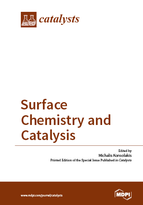Surface Chemistry and Catalysis
A special issue of Catalysts (ISSN 2073-4344). This special issue belongs to the section "Catalytic Materials".
Deadline for manuscript submissions: closed (30 November 2015) | Viewed by 99837
Special Issue Editor
Interests: heterogeneous catalysis; surface science; materials science; rational design of metal oxides; nanocatalysis; promotion in catalysis; metal-support interactions; structure-property relationships
Special Issues, Collections and Topics in MDPI journals
Special Issue Information
Dear Colleagues,
Heterogeneous catalysis plays a prominent role in our society. The majority of industrial chemical processes, involving the manufacturing of commodity chemicals, pharmaceuticals, clean fuels, etc., as well as the pollution abatement technologies have a common catalytic origin. As catalysis proceeds at the surface, it is of paramount importance to gain insight into the fundamental understanding of local surface chemistry, which in turn governs the catalytic performance.
Thanks to the surface science approach, we can obtain a profound insight into the structure of a surface, the chemical state of active sites, the interfacial reactivity, the way molecules bind and react, the role of surface defects and imperfections (e.g., surface oxygen vacancies), and the mode of action of various surface promoters/poisons. Τo elucidate the aforementioned surface phenomena, sophisticated techniques are necessary to reveal the composition and the structure/morphology of the surface, as well as the chemical entity of adsorbed species. Moreover, time-resolved methods are required to investigate the dynamic phenomena occurring at the surface, such as adsorption/desorption, diffusion and chemical reactions. The deep understanding at atomic level of catalyst surface could pave the way towards the design of novel catalytic systems for real-life energy and environmental applications
The present Special Issue is mainly focused on the recent developments in relation to catalyst surface that can be obtained by means of advanced characterization techniques (both ex situ and in situ), computational calculations (e.g., DFT method) and time-resolved methods. Studies in both model and conventional catalysts, with particular emphasis into the structure-activity relationships (SARs), are especially welcomed.
Dr. Michalis Konsolakis
Guest Editor
Keywords
- heterogeneous catalysis
- catalyst characterization
- surface analysis
- structure-activity correlation
- spectroscopic studies
- surface reactions
- time-resolved analysis
- operando studies
- tailoring surface reactivity
- computational studies






